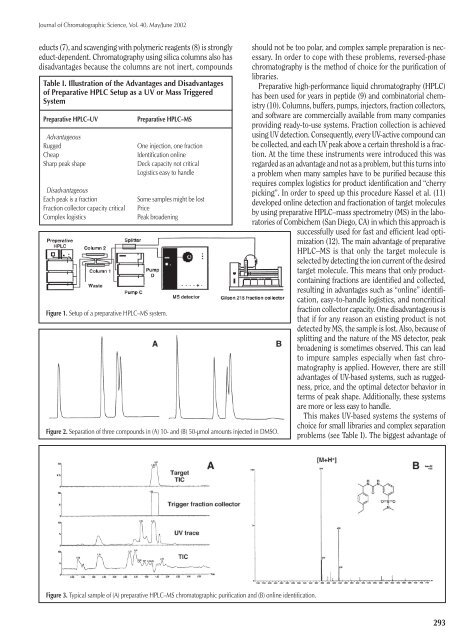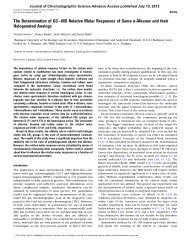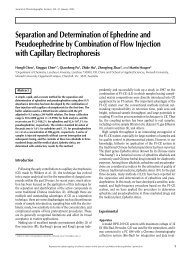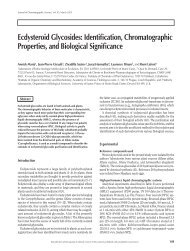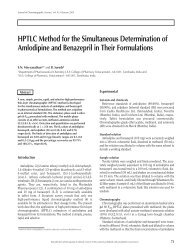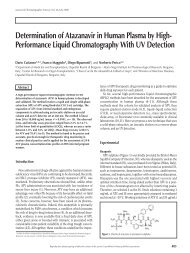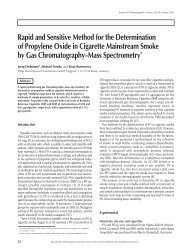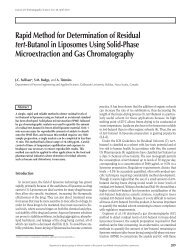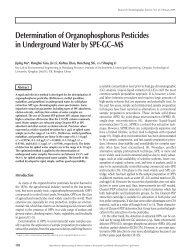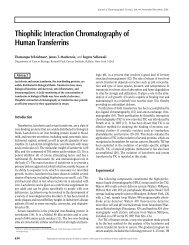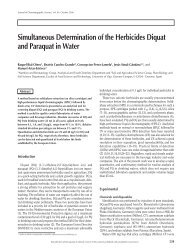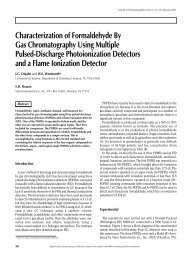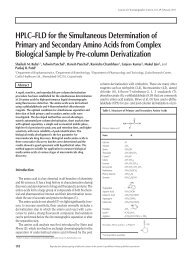Preparative High-Performance Liquid Chromatography–Mass ...
Preparative High-Performance Liquid Chromatography–Mass ...
Preparative High-Performance Liquid Chromatography–Mass ...
You also want an ePaper? Increase the reach of your titles
YUMPU automatically turns print PDFs into web optimized ePapers that Google loves.
Journal of Chromatographic Science, Vol. 40, May/June 2002<br />
educts (7), and scavenging with polymeric reagents (8) is strongly<br />
educt-dependent. Chromatography using silica columns also has<br />
disadvantages because the columns are not inert, compounds<br />
Table I. Illustration of the Advantages and Disadvantages<br />
of <strong>Preparative</strong> HPLC Setup as a UV or Mass Triggered<br />
System<br />
<strong>Preparative</strong> HPLC–UV <strong>Preparative</strong> HPLC–MS<br />
Advantageous<br />
Rugged One injection, one fraction<br />
Cheap Identification online<br />
Sharp peak shape Deck capacity not critical<br />
Logistics easy to handle<br />
Disadvantageous<br />
Each peak is a fraction Some samples might be lost<br />
Fraction collector capacity critical Price<br />
Complex logistics Peak broadening<br />
Figure 1. Setup of a preparative HPLC–MS system.<br />
Figure 2. Separation of three compounds in (A) 10- and (B) 50-µmol amounts injected in DMSO.<br />
Figure 3. Typical sample of (A) preparative HPLC–MS chromatographic purification and (B) online identification.<br />
should not be too polar, and complex sample preparation is necessary.<br />
In order to cope with these problems, reversed-phase<br />
chromatography is the method of choice for the purification of<br />
libraries.<br />
<strong>Preparative</strong> high-performance liquid chromatography (HPLC)<br />
has been used for years in peptide (9) and combinatorial chemistry<br />
(10). Columns, buffers, pumps, injectors, fraction collectors,<br />
and software are commercially available from many companies<br />
providing ready-to-use systems. Fraction collection is achieved<br />
using UV detection. Consequently, every UV-active compound can<br />
be collected, and each UV peak above a certain threshold is a fraction.<br />
At the time these instruments were introduced this was<br />
regarded as an advantage and not as a problem, but this turns into<br />
a problem when many samples have to be purified because this<br />
requires complex logistics for product identification and “cherry<br />
picking”. In order to speed up this procedure Kassel et al. (11)<br />
developed online detection and fractionation of target molecules<br />
by using preparative HPLC–mass spectrometry (MS) in the laboratories<br />
of Combichem (San Diego, CA) in which this approach is<br />
successfully used for fast and efficient lead optimization<br />
(12). The main advantage of preparative<br />
HPLC–MS is that only the target molecule is<br />
selected by detecting the ion current of the desired<br />
target molecule. This means that only productcontaining<br />
fractions are identified and collected,<br />
resulting in advantages such as “online” identification,<br />
easy-to-handle logistics, and noncritical<br />
fraction collector capacity. One disadvantageous is<br />
that if for any reason an existing product is not<br />
detected by MS, the sample is lost. Also, because of<br />
splitting and the nature of the MS detector, peak<br />
broadening is sometimes observed. This can lead<br />
to impure samples especially when fast chromatography<br />
is applied. However, there are still<br />
advantages of UV-based systems, such as ruggedness,<br />
price, and the optimal detector behavior in<br />
terms of peak shape. Additionally, these systems<br />
are more or less easy to handle.<br />
This makes UV-based systems the systems of<br />
choice for small libraries and complex separation<br />
problems (see Table I). The biggest advantage of<br />
293


